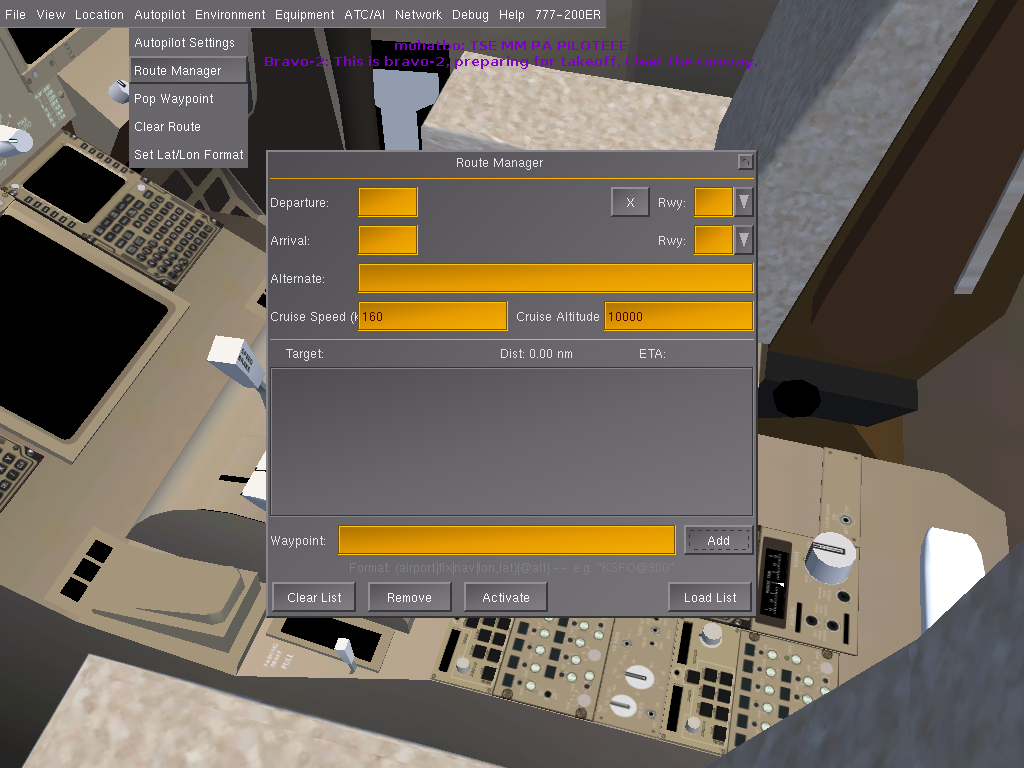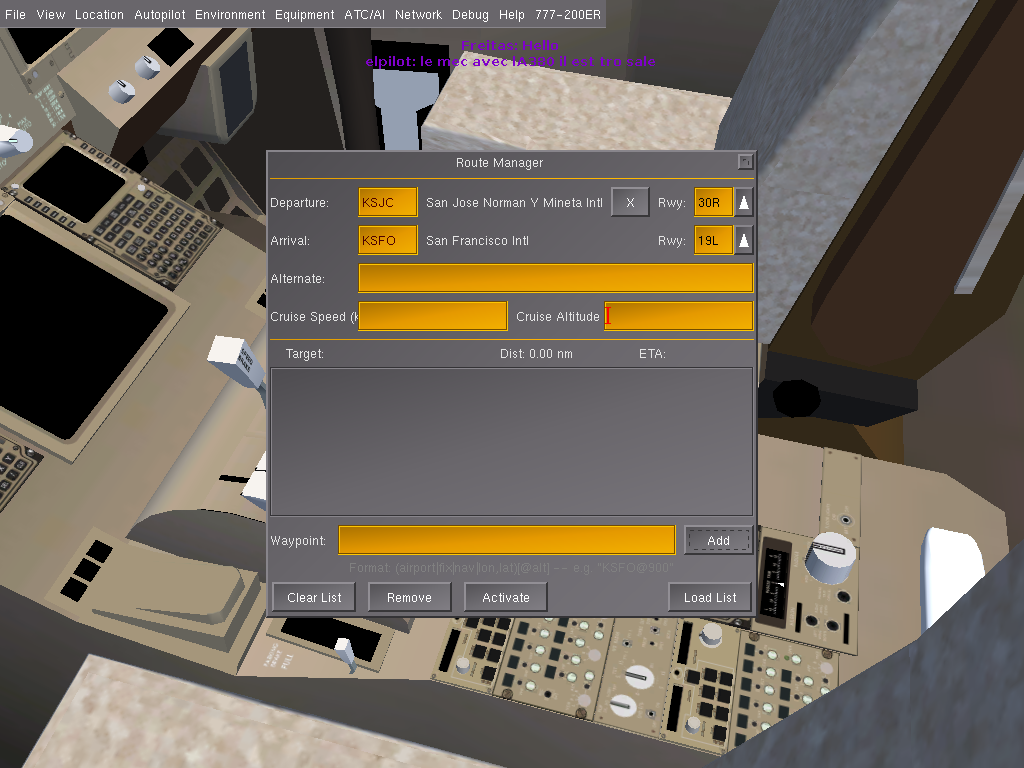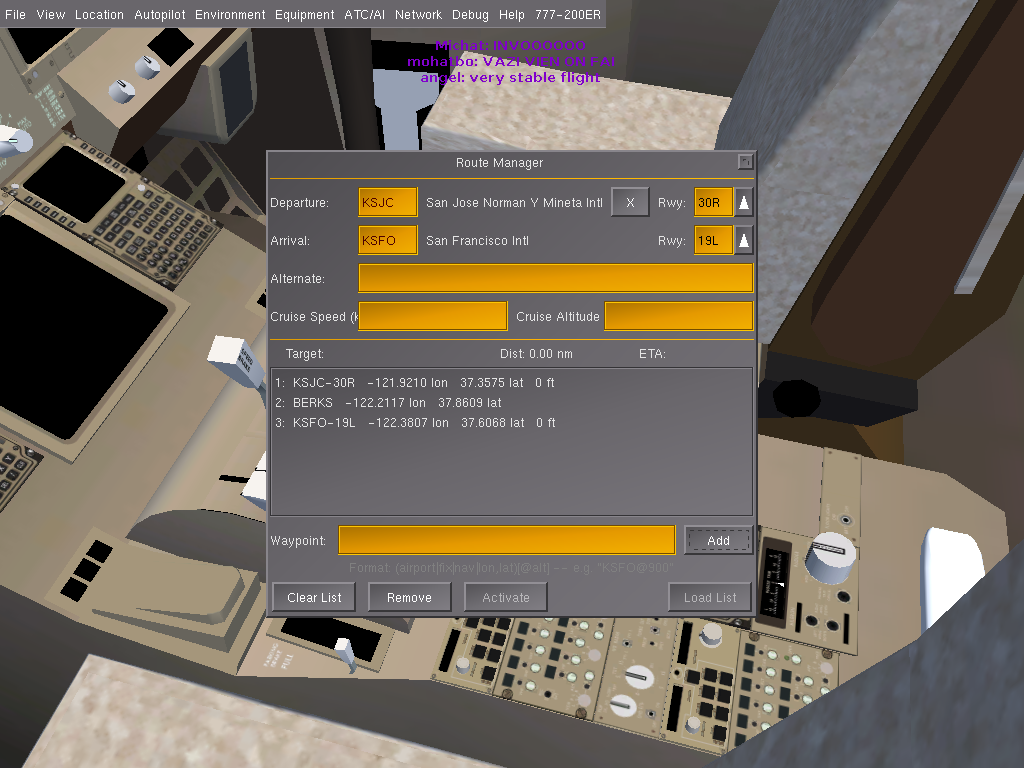Boeing 777 Tutorial: Version 2.0: Difference between revisions
(Created page with 'It can fly an entire route on one engine. It can carry over 350 passengers for about 9,000 miles. And this gargantuan monster, with a wingspan of nearly 200 feet and a weight of …') |
No edit summary |
||
| Line 35: | Line 35: | ||
Now, go to your autopilot. To engage the route manager, the function is "LNAV". | Now, go to your autopilot. To engage the route manager, the function is "LNAV". | ||
=PAGE IN PROGRESS= | |||
Revision as of 20:29, 3 May 2010
It can fly an entire route on one engine. It can carry over 350 passengers for about 9,000 miles. And this gargantuan monster, with a wingspan of nearly 200 feet and a weight of over 300,000 pounds, is operated on fly-by-wire technology. It's the legend of airliners, as in FlightGear. It's the Boeing 777-200 ExtendedRange.
So you've just sat down in the cockpit of this very complex aircraft. With a cockpit and instruments that were given a makeover in version 2.0, it's no surprise to see why you might be a bit overwhelmed. Today, that changes as you take to the skies, as the captain of the Triple 7.
Startup
The 777 is one of FlightGear's most ready-to-fly aircraft. You should start out with a good amount of fuel in your tanks, but to be certain, check it in your Equipment-Fuel and Payload box. Add or decrease fuel by dragging each indicator to the desired amount. Since there's a tank in the center and a tank on each wing, you should try and make it balanced; the amount of fuel in the center tank can be anything you want, but try to make the fuel in each wing equal.
'IMPORTANT: There is some debate as to whether or not restarting/repositioning messes up the 777 ILS. Make sure that this your initial' start from the wizard; not a restart or reposition. Just the first flight in FGFS since you clicked "run" on the wizard.
You can also adjust the amount of passengers (PAX) and crew.
Once you've got your desired load, click on the "777" menu on the top of the screen. You should see an "autostart" pop up. Click on that, and the aircraft will come to life! Now, all we've got to do is set our instruments.
Getting AP/ILS info
Whether you're new to the triple 7 or confused about some new 2.0 stuff, the 777 Autopilot might seem a bit confusing. But there's one thing to remember: half of it you will never use. When navigating to an airport, there's really only two parts of the AP: using waypoints to get to the approach for a runway, and then using a localizer, or runway frequency, for your final approach (most localizers only extend for about 20 miles, meaning the waypoints are neccessary).
Before you do anything involving AP, you must first get the neccessary data for it. airnav.comis a great place to get it; simply go to the "airports" tab and type in the airport code. So, for example, if you typed in "KSFO", you should get a whole page on it. Scroll down to the bottom where there's a bunch of PDFs labelled "IAPs- Instrument Approach procedures". Decide on the runway you are going to use, but note that only certain runways are equipped with ILS; at KSFO, it's really only 28R/28L/ and 19L. Under IAPs, look for the "ILS OR LOC RWY __" or something like that, with the desired runway number in it. ONLY use the IAPs with "ILS/LOC" or "ILS RWY". In other words, use the ones at the tippy top.
Click "download" on the IAP you want to use. I'm going to use "ILS OR LOC RWY 19L **CHANGED**", for 19L at KSFO. You should see a chart, but it may be hard to distinguish the waypoints. So scroll to the bottom where you basically see a narrowing arrow with three waypoints. The ones with "int" mean intercept, so don't include the "INT". The three waypoints in this case, in order, are "BERKS INT", "SHAKE INT", and "ROGGE INT". So, you really only the first one "BERKS" to get within range of the localizer. For the localizer, you should see a box that says "LOCALIZER- 108.9, ISIA". The ISIA is the identifier you should get on your NAV display. So write those two down- "BERKS" and "108.9, ISIA".
Setting your Instruments
Now, head on back to FlightGear and back to your cockpit. First, let's take a look at the Route manager: (under Autopilot-Route Manager):

So you've got your Departure Airport, Departure runway, Arrival Airport, Arrival Runway, and Waypoints; erase EVERYTHING in the boxes. Now, fill in the departure and arrival information. Click "X" for the runway dropdown menu. Make sure you pick the departure runway you intend to depart from.
So: (let's say we're departing from KSJC).:

Now it's time to add in "BERKS". We type "BERKS" into the "add waypoint" box and click Add Waypoint. Then, delete the 0s in the Altitude/speed box" and click activate, and it should look like this:  .
.
Now, go to your autopilot. To engage the route manager, the function is "LNAV".